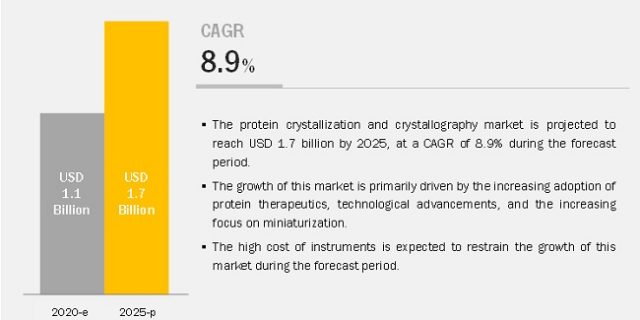
The Protein Crystallization Market is projected to reach USD 1.7 billion by 2025 from USD 1.1 billion in 2020, at a CAGR of 8.9% during the forecast period.
Protein Crystallization & Crystallography Market and Top technologies :
X-ray crystallography – XRC is a widely used technology for protein analysis and provides data on protein structures at the atomic level, which serves to provide a greater understanding of protein function in terms of their interaction with other molecules, the ability to undergo conformational changes and to perform catalysis in the presence of enzymes. The components used during X-ray crystallographic analysis include protein crystals, X-ray generators, and electronic X-ray detectors.
NMR Spectroscopy – NMR spectroscopy is a complementary technology to X-ray crystallography, used to determine a protein structure. In contrast to X-ray crystallography, NMR spectroscopy uses proteins in soluble forms.
Cryo-Electron Microscopy – Cryo-electron microscopy is an emerging technology where protein samples are studied at cryogenic temperatures (the temperature of liquid nitrogen). As these studies are carried out at cryogenic temperatures, they offer various advantages.
Request Research Sample Pages: https://www.marketsandmarkets.com/requestsampleNew.asp?id=147057058
The protein crystallization market is estimated to witness tremendous growth in the next five years as it comprises automated systems that offer very high sensitivity. In addition, protein purification, reagents/consumables, X-ray, and the crystallography segments of the crystallization of protein market are projected to see high growth rates on account of a large number of ongoing research projects in the domain. Thus, the emerging markets of Asia as well as the electrophoresis technology for protein purification are the new revenue sources for the protein crystallization market.
The Americas and Europe are the established markets for protein crystallization and crystallography. The developing regions, including BRIC (Brazil, Russia, India, and China) countries, are expected to form the new revenue pockets for this market. A rise in the spending power of these countries is the major driver for the growth of crystallization of protein.
The consumables segment accounted for the largest market share in 2019.
On the basis of product and service, the consumables segment accounted for the largest share of the protein crystallography market in 2019. This can be attributed to a large number of reagent kits and microplates used in proteomics research and the increasing demand for miniature screening plates in automated liquid handlers.
The pharmaceutical companies segment accounted for the largest market share in 2019.
The pharmaceutical companies segment accounted for the largest share of the protein crystallization market in 2019. This can be attributed to the increasing demand for protein-based drugs and the increasing demand for biologics in various application areas.
Download PDF Brochure: https://www.marketsandmarkets.com/pdfdownloadNew.asp?id=147057058
Geographical View in-detailed:
The protein crystallization and crystallography market is divided into five major regions, namely, North America, Europe, Asia Pacific, and the Rest of the World (RoW). In 2019, North America accounted for the largest share of the global protein crystallography market, followed by Europe. The growth in this market can be attributed to the increasing investments in the development of structure-based drug designs, growing academic and government investments in genomics and proteomics research, and rising focus of stakeholders on research projects involving proteins.
Key Market Players;
The major companies in the protein crystallization and crystallography market are Rigaku Corporation (Japan), Hampton Research (US), Jena Bioscience GmbH (Germany), and Bruker Corporation (US).


